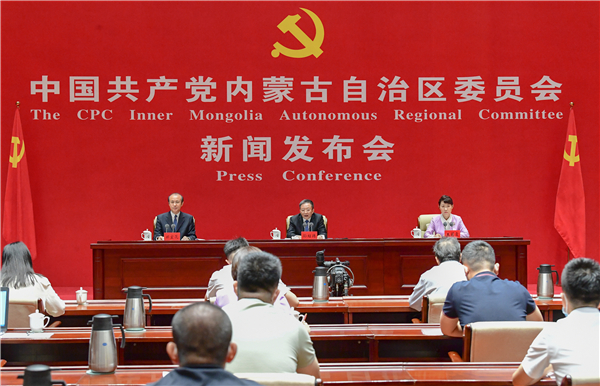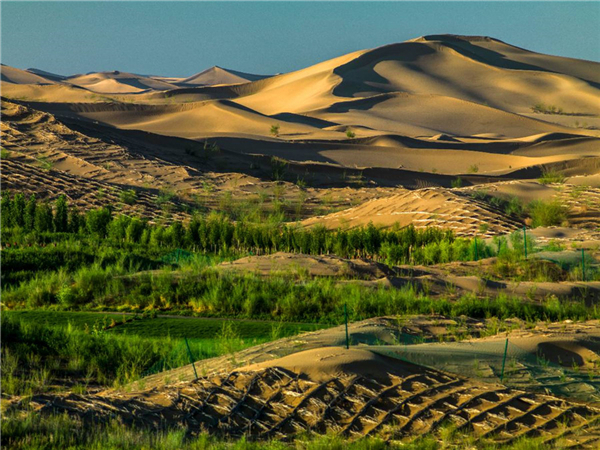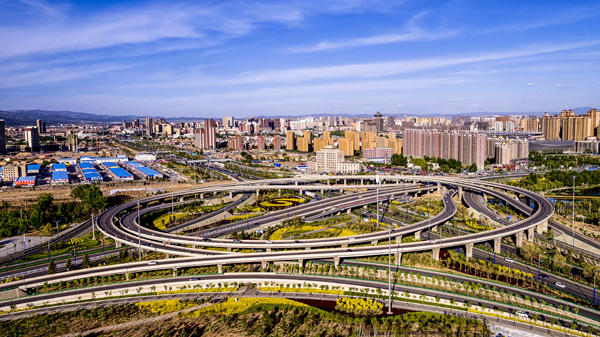Inner Mongolia experiences tremendous development in 10 years

Inner Mongolia holds a press conference to introduce its economic and social development since the 18th National Congress of the Communist Party of China that took place in November 2012. [Photo by Yuan Yonghong for chinadaily.com.cn]
North China's Inner Mongolia autonomous region has maintained strong economic development, ethnic unity, social stability and borderland tranquility since the 18th National Congress of the Communist Party of China that took place in November 2012.
This was stated at a press conference held in the region's capital city Hohhot on Aug 22.
The press conference introduced the great changes and remarkable achievements Inner Mongolia has made over a 10-year period.
Since 2012, Inner Mongolia has been exploring a new path of high-quality development focusing on ecological priorities and green development.
It is committed to building itself into an important ecological security barrier and stability barrier in northern China, a national energy and strategic resource base, a national agricultural and livestock production base, and a bridgehead for the country's opening to the north.
The region's GDP crossed the 2 trillion yuan ($300.08 billion) mark in 2021, and its per capita GDP had increased from 42,000 yuan in 2012 to 85,000 yuan in 2021, ranking tenth in the country.
A total of 1.57 million registered poverty-stricken people in Inner Mongolia have all been lifted out of poverty.

The use of sand barriers helps transform hundreds of acres in northern China's Kubuqi Desert into green landscape. [Photo provided to chinadaily.com.cn]
From 2012 to 2022, a total of 122 million mu (8.13 million hectares) of trees and 286 million mu of grass were planted in Inner Mongolia. The grassland vegetation coverage and forest coverage rate there increased from 40.3 percent and 20.8 percent to 45 percent and 23 percent, respectively, and the area of desertified and sandy land in the region has continued to decrease.
In the same period, Inner Mongolia developed a modern energy economy. The total installed power capacity of Inner Mongolia reached 156 million kilowatts.
Of which, the new energy installed capacity in the region reached 56 million kilowatts, accounting for more than one third of its total installed power capacity, and the new energy power generation reached 119.1 billion kilowatt hours, ranking first in the country.
Meanwhile, Inner Mongolia has had a cumulative coal production of 9.89 billion metric tons and a power generation of 4.9 trillion kilowatt hours over a 10-year period. The region has also built the country's largest coal power and coal chemical base.
Moreover, the region's rare earth in situ conversion rate has exceeded 75 percent.

Herders take care of their camels on a breeding farm in Alshaa Right Banner, Inner Mongolia autonomous region. [Photo/China Daily]
In terms of the development of agricultural and livestock industries, Inner Mongolia's grain output has exceeded 35 billion kilograms for four consecutive years, ranking sixth in the country.
The output of mutton, beef, milk and cashmere in the region accounts for about one fifth, one tenth, one fifth and a half of the country's total, respectively.
China's dairy giants Yili and Mengniu, both headquartered in Inner Mongolia, have made the list of the world's top 10 dairy enterprises, ranking fifth and seventh respectively.
Additionally, in the past ten years, Inner Mongolia has continuously expanded its opening to the outside world, comprehensively strengthened regional cooperation, and served and integrated into the new development pattern.
The operating mileage of railways in the region has increased from 9,400 kilometers to nearly 15,000 km, ranking first in the country.
The newly-added highway mileage in the region has reached 49,000 km, and the number of civil airports has increased from 15 to 43.
The number of open ports in the region has increased from 12 to 20, and the freight volume of Inner Mongolia's border land ports has ranked first in the country.

Inner Mongolia is seeing rapid development of its road network. [Photo/chinadaily.com.cn]



 Print
Print Mail
Mail


